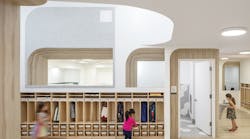In two other articles included in this issue of LEDs Magazine, you will find some discussion on the future of the replaceable bulb — or what most accurately is called a replacement or retrofit lamp — in the LED era with extremely long-life sources. The future of the bulb was one of the topics in the Lovers of Light panel at Strategies in Light and I wrote about that panel in this issue. Moreover, Clifton Stanley Lemon contributed the Last Word column in this issue and also debated the merits of the bulb in the aforementioned panel.
You can read those two articles to learn more about the debate. From my perspective, thinking more as an engineer than a user or specifier of LED-based lighting, I’d judge the bulb form factor to be outdated and not a match for solid-state lighting (SSL). It would be nice to reimagine a replaceable, retrofit-capable form with a blank sheet of paper.
Now in the commercial space, the bulb is not an issue other than in the case of fluorescent-replacement LED tubes. Companies around the globe have an installed base of troffers that they won’t abandon anytime soon. LED tubes remain a compromise in terms of efficiency, expected life, and light quality. One only has to walk through a building with badly-mismatched fluorescent tubes in terms of CCT or spectral power distributions (SPD) to see how willing businesses are to accept poor lighting.
In spaces where quality of light matters, businesses are more likely to install integral luminaires with no replaceable light engine. Such specifiers willingly accept the fact that they may have to pay for a fixture replacement should one fail prematurely while specifying products with lifetime that stretches beyond when the lighting would be due for a retrofit.
But let’s address the residential consumer market. I was listening to a sports-talk-radio personality recently who, for some reason, wandered off on a tangent about a stairwell light fixture in his home that had failed. Evidently, he climbed a ladder in a fairly precarious location only to find out that the luminaire had no replaceable light source. He was completely shocked that such a thing existed. And I know this person to be relatively tech savvy and just at the upper edge of the millennial age range. He questioned why anyone would have been so stupid to have installed such a product.
The fact is that the residential market is going to demand replacement lamps for a long time to come. It was probably a missed opportunity for a company or an alliance to capitalize on a new modular standard. And yes, I know there have been attempts in that area. The Zhaga Consortium did some good work in the area, although it really focused on commercial applications.
The most promising modular approach I can remember was the Helion concept championed by Bridgelux and Molex. It’s hard to believe, but that was almost a decade ago when the companies launched Helion going into LightFair. At that time, however, LED lighting was struggling mightily with high up-front costs. And adding to the bill of materials was a non-starter. Moreover, A-lamp sockets were ubiquitous.
I would suggest that there might be opportunity yet for a new modular concept. But as I covered in an article on Strategies in Light keynotes, the industry is now making LED lamps that cost less than incandescent lamps.
Maury Wright,
EDITOR





